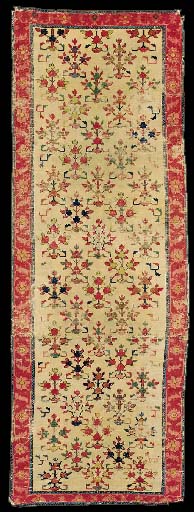|
Lot 25 - A NORTH CAUCASIAN RUNNER
SEYCHOUR DISTRICT, FIRST HALF 19TH CENTURY
Price Realized £23,500 ($33,723)
Estimate £30,000 - £50,000 ($43,050 - $71,750)
Sale Information
Christies Sale 6435
ORIENTAL RUGS AND CARPETS
3 May 2001
London, King Street
Lot Description
A NORTH CAUCASIAN RUNNER
Seychour District, first half 19th Century
The white ground with diagonal rows of polychrome floral sprays overall and
a small rose-coloured goat in the lower right corner, all within a rose
tone-on-tone palmette, curling leaf and flowerhead meandering vine border
between narrow deep brown and pale indigo reciprocal Y-motif guard borders,
reduced in length, partial end borders with outer guard stripes re-attached,
ends bound, partially oxidized browns, minor repairs
9ft.11in. x 3ft.5in. (302cm. x 104cm.)
Pre-Lot Text
THE BERNHEIMER WHITE GROUND CAUCASIAN RUNNER
Provenance
Acquired 9 August 1937 as a "Yordes"
Literature
Alte Teppiche des 16.-18.Jahrhunderts der Firma L.Bernheimer, Munich, 1959,
pl.30.
Schürmann, U.: Teppiche aus dem Caucasus/Caucasian Rugs, Braunschweig, n.d.
(1964), pl.114.
HALI, Vol.I, no.3, (1978) p.300, pl.1.
Lot Notes
Warp: wool, ivory with a few light brown threads, Z3S, hardly undulating
Weft: 2 shoots, white cotton, Z2S, undulating
Pile: wool, Z2S, sometimes single strands of light grey and violet,
symmetrical inclining to the right, H3.0 x V3.9/cm.
Remarks: sometimes irregular knotting; to compensate at times one or other
of the loops of a knot is passed around two warps
This rug is remarkable both for the field design and for its border. The
combination of the floral meander border design with its execution in two
tones of pink appears in the well-known Seychour rugs of the nineteenth
century. The proportions here are however considerably more open, which is
usually considered an early feature in Caucasian rugs, making a date of the
late eighteenth or early nineteenth century most probable. Schürmann dates
the rug to the 17th/18th century, but at this date it would have no
stylistic counterparts at all within the known corpus of carpets.
The field design shows clearly the influence of South Persian 'vase' carpets
of the seventeenth century. Various other instances of this movement of
designs from 17th century Kirman to 18th century North West Persia can be
observed within the Bernheimer Collection (cf. Christie's, 14 February 1996,
lots 59 and 151 for example), but rarely can it be seen as clearly as here
having travelled well into the Caucasus. As ever in the later developments
the design has been simplified and made more angular, while at the same time
having less variation within the individual motifs. Nevertheless the
influence of rugs such as one in the Victoria and Albert Museum (Martin, F.R.:
A History of Oriental Carpets before 1800, Vienna, 1908, p.87, fig.185) is
very clearly observable.
This rug appears to be unique in the publications of Caucasian rugs, its
design and colouring providing a fascinating illustration of the weavings of
the Northern Caucasus at this formative stage.
|

|

